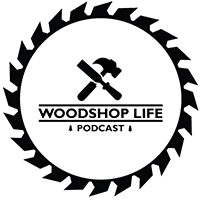Support us on Patreon: https://www.patreon.com/woodshoplife
Sean
1) I’ll save you the airtime by not mentioning how awesome y’all are and how awesome your podcast is because you already know that. If Huy and Sean didn’t know that already just ask Guy… he will talk for hours! Hahah
Two part question is… when contemplating buying a new tool do you let the space you have for that tool determine if you’ll be getting one over the other? Also, when you bring a new tool into the shop do you find yourself using that tool as an excuse to rearrange your shop, even if it’s an upgrade from a tool you already have?
I’ve found myself rearranging my entire workflow every time I introduce a new tool even if the one I’m upgrading one that’s been in a certain spot for years.
I hope all has been well with you and your families. Please continue with the fantastic content! Thank you for your time.
Brent Jarvis
Clean Cut Woodworking
2) Hey fellas, I’m looking into a new drill press. I’m looking to spend about 500$. I noticed the rikon radial arm drill press is the same price as the standard drill press. why wouldn’t I buy the radial arm drill press?
Thanks Scott
Huy
1) Howdy from Madison, AL! I’m pretty new to woodworking although
I have been building (and finally finished) our kitchen cabinets including 43 drawers! Now I’m getting into ‘finer’ woodworking and am building a 2” thick (6’x4’ oval) walnut/maple kitchen table. My question is about building a base for the table – any idea how to prototype the build so that I can see if the base will actually hold all the weight of the table? I can build it in Sketchup but that really won’t tell me how much weight it will support… I also thought about building a ‘tulip’ style base as our home has very contemporary styling…
Adrian Abshire
2) First off, this MAY be a repeat (I’ve sent it to SOME podcast but who can keep them all straight ?). I’m making a high chair for a friend, which I hope to complete before the kid goes off to college, from box store mahogany so I’m thinking it’s sapele. I’d love suggestions on how to finish so it’s both durable and safe for a tiny human to gnaw on
Jason
Guy
1) Hey guys I’ve been listening from the start. Awesome podcast and has been super informational so thank you for all you do. My question to you guys is, is it worth upgrading my dwelt 734 to a helical head or buy a new 735 four post and upgrade the head later on?(money reasons for later on) The 734 has worked great for my for about 3 years. My only complaint is the knives are crap. They don’t last very long. My question is it worth upgrading the old 734 Vs getting a new four post and upgrading later. It’s a better machine so maybe it will last longer in the end. Thank you for your time! Mike
2) Hello. My brother-in-law’s house flooded during a recent hurricane. They have a heavy duty metal circular staircase that had carpet covered plywood stair treads that were trashed. I’ve made new stair treads with red oak and was planning to use Osmo to finish, but now they say they want them “dark”.
What product would you recommend to both darken and seal that would hold up long-term to foot traffic. I’m thinking a stain with Osmo might eventually wear off leaving an uneven color.
Thanks in advance, Mike Sibley Sibley Manor Woodworks
